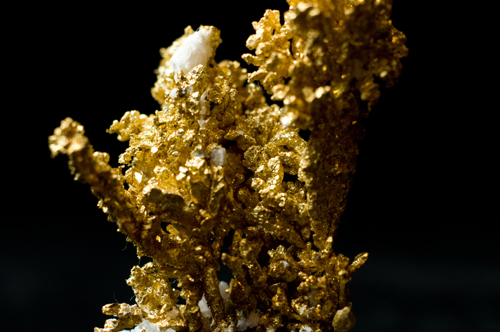
It puts the current gold market into perspective when one looks back just a couple of years. In 2012 when we last looked at Alacer Gold's Çöpler gold mine gold prices stood at just over $1,000 an ounce. Since then they have risen of course to as high as $1,800 in mid-2011 before setting out on a steady decline. Nevertheless at the time of writing, at a level of £1,246 an ounce they are still above what was then considered a very positive level for the TSX listed company, which in 2014 expects to produce at Çöpler 160,000 to 180,000 ounces of gold at all-in cash costs of between $730 and $780 per ounce.
Alacer owns an 80 percent interest in the mine, with the remaining 20 percent held by its minority Turkish partner Lidya Madencilik San. Ve Tic, A┼× (Lidya Mining). Lidya Mining is owned by Çal─▒k Holding A┼×, a multi-billion dollar Turkish conglomerate that is enthusiastic about Turkey’s mineral potential. Alacer first acquired an interest in Çöpler more than twelve years ago, and by 2004 it had acquired 100 per cent control of the property. At that stage, all it really owned were the rights to mine what was still virgin territory, however in 2009 it entered a strategic relationship with Lidya Mining, and construction of the mine began not long after, with the first gold being poured December 2010 and full commercial production announced a few months later. Çöpler exceeded expectations during its first year of operations. Commercial gold production came on stream earlier than planned and in total the mine produced 185,418 ounces of gold at a cash operating cost of $322 per ounce. Mining of the Manganese Pit commenced during 2010, and mining of the Marble and Main Pits commenced during 2012.
The Manganese Pit has provided the greater part of ore thus far, however, the balance is planned to shift to the Main Pit from the second half of 2014. Processing of oxide ore started in 2011 with a three-stage crushing circuit nominally rated at 15,500 tonnes per day (tpd). Toward the end of last year a parallel clay handling circuit was commissioned to enable processing of ore with a higher clay content. The Çöpler plant now has a capacity of 17,000 tpd. The crushed ore is then delivered to the heap-leach pad. To extract the gold from the ore, a low-concentration cyanide solution is applied to the agglomerated ore on the leach pad using a low-pressure irrigation drip system. Doré bars are produced on site and transferred to third-party refineries for final recovery of gold and minor amounts of silver. Over the life of the current heap-leach project, approximately 63 percent of the gold contained in the oxide ore is expected to be recovered.
It has been a very successful low cost operation, in some contrast to the mines Alacer owned in Australia. The latter returned a poor operating performance, which coupled with the declining gold price last year convinced the directors that the best course of action would be to sell the Australian assets and focus the company's efforts on Turkey. This was an opportunity for further restructuring and cost reduction, said CEO Rodney Antal in his review of last year's performance. “The restructuring of our business has also included reductions in the management team and corporate overheads. Following these necessary changes Alacer is now well placed to execute our new strategy in a cost-effective manner.”
He claims that better than expected oxide ore grades and a steady improvement in heap leach gold recoveries will contribute to making Çöpler one of the lowest cost gold mines in the world during 2014. There are two forms of mineralisation at Çöpler, oxide and sulphide forms, making the ore amenable to conventional open pit mining. The oxide ores are being processed in a simple crush, agglomeration and heap leach circuit. For the deeper sulphide mineralisation, Alacer is at an advanced stage of a definitive feasibility study (DFS) to evaluate the treatment of sulphide ore via a system known as whole-ore pressure oxidation (POX). It is notable, he adds, that the grade of sulphide ore mined during 2013 was significantly higher than had been predicted, with positive gold reconciliation averaging 39 percent on a contained ounce basis. An extensive work programme is currently being undertaken, in conjunction with the DFS, to understand these positive gold reconciliations.
During 2013 Çöpler Gold Mine proved that it is truly a world class asset by producing 271,063 ounces of gold at total cash costs of just $429 per ounce from heap leaching of oxide ore. The mine has very substantial proven and probable reserves of 3.6 million ounces of contained gold and measured and indicated resources of 8.5 million ounces. Located in central eastern Turkey, roughly 550 kilometres to the east of Ankara and 120 kilometres south west of the city of Erzincan, the nearest population centre is the town of ─║liʽ (population 3,000) which is just six kilometres from Çöpler. In 2013, the Çöpler joint venture started to fund a regional school in ─║liʽ. It is estimated that $2.8 million will be invested in this project by the end of 2015.
A surface gold mine is very different from an underground coal operation but there is no denying that the recent horrifying accident at the Soma mine in western Turkey has focused world attention on safety in the industry. Safety programmes include training for all employees, special training for exploration and emergency response teams, recognition for safety achievement, and a steady flow of information that keeps people focused on continuous safety improvement. It is gratifying then to be able to record that in 2013 more than three million man-hours were worked at Çöpler without a single lost time incident (LTI) up to March this year – during a period when the mine hit record production, 28 percent better than had been predicted. “I am very excited about the progress being made during 2014 and the direction in which the company is now headed,” says Antal. “Alacer is in an excellent position to capitalise on the transformational changes made during 2013.”
Written by John O’Hanlon, research by Abi Abagun



 AlacerGold-Europe-Mining-Jun14-Bro-s.pdf
AlacerGold-Europe-Mining-Jun14-Bro-s.pdf









